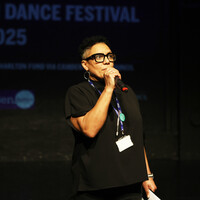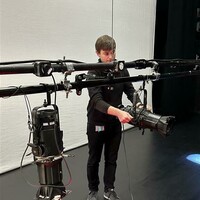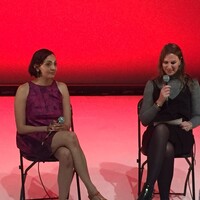Temitope Ajose reflects on her role as Artist Associate at The Place
News Story
Since 2024, The Place invites an Artist Associate to embed themselves in the artistic life of The Place through advising, supporting and championing dance artists who are developing their practice and/or new work, curating and inputting into the strategic direction of artist development programmes at The Place and developing their own practice through research and teaching in collaboration with London Contemporary Dance School. Temitope Ajose was Artist Associate at the Place from January 2025 - October 2025.
It’s hard not to feel the weight of our times: wars, political unrest, climate change, cuts, inflation, the cost of living. At times it feels as though the world’s troubles seep beneath the skin, and I find myself hesitating to name them aloud, for fear of deepening the collective gloom. Yet I often wonder whether artists are particularly porous to the world’s temperature, absorbing its griefs and hopes by osmosis, translating the macrocosm into the body.
Over the past year, I’ve caught myself asking: Why still be in dance? Why still make dance? What relevance does it hold? Looking out across the dance community, I saw artists still engaged, still questioning, creating, and fighting for their place within the shifting landscape.
So when I was invited to curate a new series of webinars for dance artists, I wanted to gather those who continue to sustain their practice in inventive, authentic ways. What began as a plan for five sessions quickly grew into something larger: pairings of artists whose intergenerational dialogue could expand knowledge and spark connection. What happens when mature and emerging artists speak from different lenses? What might we learn from each other? And how might those conversations help us make sense of where we find ourselves now?
What emerged were enlivening, nuanced exchanges with courageous souls who gave their time and energy to wrestle with big questions. Often, I felt less like a host and more like a privileged listener at a table of brilliant minds. Ideas collided, laughter and pathos intertwined, and I left each session inspired, eager to share fragments of their insight.
There were six webinars in total, each rooted in ideas long circling within the Artist Development team. Perhaps, in truth, they were also a personal attempt to understand the world and sector I inhabit - a way of seeking light through conversation.

Temitope is dancer and and creator, who's worked at venues including The Royal Opera House, The Place, DanceXchange, RichMix, Dancebase and the Soho Joyce in New York.
As a dancer, Temitope has worked with Punchdrunk, Director Carrie Cracknell at The Gate Theatre and The National, Theo Clinkard, Protein Dance Company, Lea Anderson, Joe Florence Peake, Adelaide Cioni, Sam Williams and Megan Rooney. Temitope also engages in movement direction (The Old Vic and National Theatre) and for Artist Megan Rooney on her solo shows, at Kunsthalle Germany, Salzburg Kunstverein and The Lyon Biennale.
Access in Process
Artists Annie Edwards and Stuart Waters opened the series, exploring what it means to centre access within creative work. Both have navigated systems that often overlook or fail to accommodate them, developing psychological and physical frameworks that allow their practice to thrive. They spoke of Crip Time, a concept from Alison Kafer’s Feminist, Queer, Crip, as a reorientation of time that honours lived experience over productivity. Their insights reminded me that access is not a fixed model but a living, relational practice.
As Annie reflected, “I was feeling a desperate need to not work for people for a while and figure out what was in my dance… without ableist structures, shedding, being by
myself, having lots of open time and space.” Stuart added, “allowing disability to design space and time.” Together, they somehow called in a new world, one where dance-making truly adapts to the people in the room, rather than asking people to adapt to the current structures that dance is currently made.
Destabilising and Queering Art-Making
With Adrienne Ming and Charlie Morrissey, the conversation moved into queerness, identity, and creative freedom. Ming spoke of discovering performance as a space where “alternate realities can be made,” recalling early drag explorations as acts of play and freedom of expression. Charlie reflected on growing up in the 1980s, where self-expression often felt like an “alien aberration” to be pushed back inside.
Their exchange was messy, playful, and full of joy - a reminder that art-making rarely follows a clean trajectory. As Ming said, “I love making a mess.” To which Charlie replied, “We can have a whole practice which is about you making a mess and me cleaning it up.” That single moment, mischievous yet profound, embodied the spirit of the series: hope, imagination, and a radical openness to possibility.
Improvisation: The Last Bastion of Freedom
Seke Chimutengwende and Ellie Sikorski explored improvisation as a space of agency. Seke described searching for “something unhindered,” while Ellie spoke of “the joy of doing whatever I feel like doing.” Their words resonated deeply. Improvisation, in its truest form, is choice, permission, and embodied freedom, an act of resistance in a world of control.
Seke noted that much improvisation happens outside institutional funding, where the practice can remain unconstrained. It reminded me that freedom often comes at the cost of visibility and capital, and that some of the most radical work lives at the edges.
Disruptive Bodies
Tamm Reynolds and Liz Rosenfield cut to the heart of how bodies disrupt expectation and perception. “I have been thinking a lot about my work in relation to being a disruptive body,” Tamm began, “who calls themselves a curated version of the slur that is used against me.” What followed was a fierce and funny exchange on body politics, queer identity, and survival.
Liz spoke of re-meeting the body anew with every work, refusing to see it as fixed. They described Rosenfeld’s work Tremble, a durational performance emerging from
reflections on queer desire and absence during lockdown, where trembling became a rich practice, with multiple meanings and readings such as fear, pleasure, and persistence. Their conversation reminded me that sometimes, simply existing in one’s truth can be a radical act of disruption.
Sustaining Practice in Troubling Times
The final webinar, with Katye Coe and Bakani Pick-Up, circled the question that had guided the entire series: How do we keep doing what we’re doing?
Both artists spoke of resilience, community, and reimagining how to stay grounded within instability. Katye described joining a community in Hebden Bridge, where daily open practice keeps her connected to others through movement. Bakani reflected on navigating freelance life as an immigrant artist — shifting between invisibility and hyper-visibility, always adapting.
Their conversation returned often to community as a source of sustenance and to therapeutic practices that deepen self-awareness. Katye’s somatic work and Bakani’s person-centred approach both speak to a dance ecology where empathy and care become radical tools for survival. As Katye noted, “What do I need to keep showing up? Community.”
Across all six webinars, a common thread emerged: resilience, curiosity, and care. These artists with their vulnerability, humour, and brilliance reminded me that even in turbulent times, dance remains a vital act of connection and imagination.
As we gathered each week, laptops glowing in dimly lit rooms, I felt part of something alive, a small but powerful community finding sense and hope together. My gratitude to all who took part or listened in. These conversations, in their honesty and generosity, rekindled faith in what artists do best: feeling the world through the body, and finding new ways forward.


